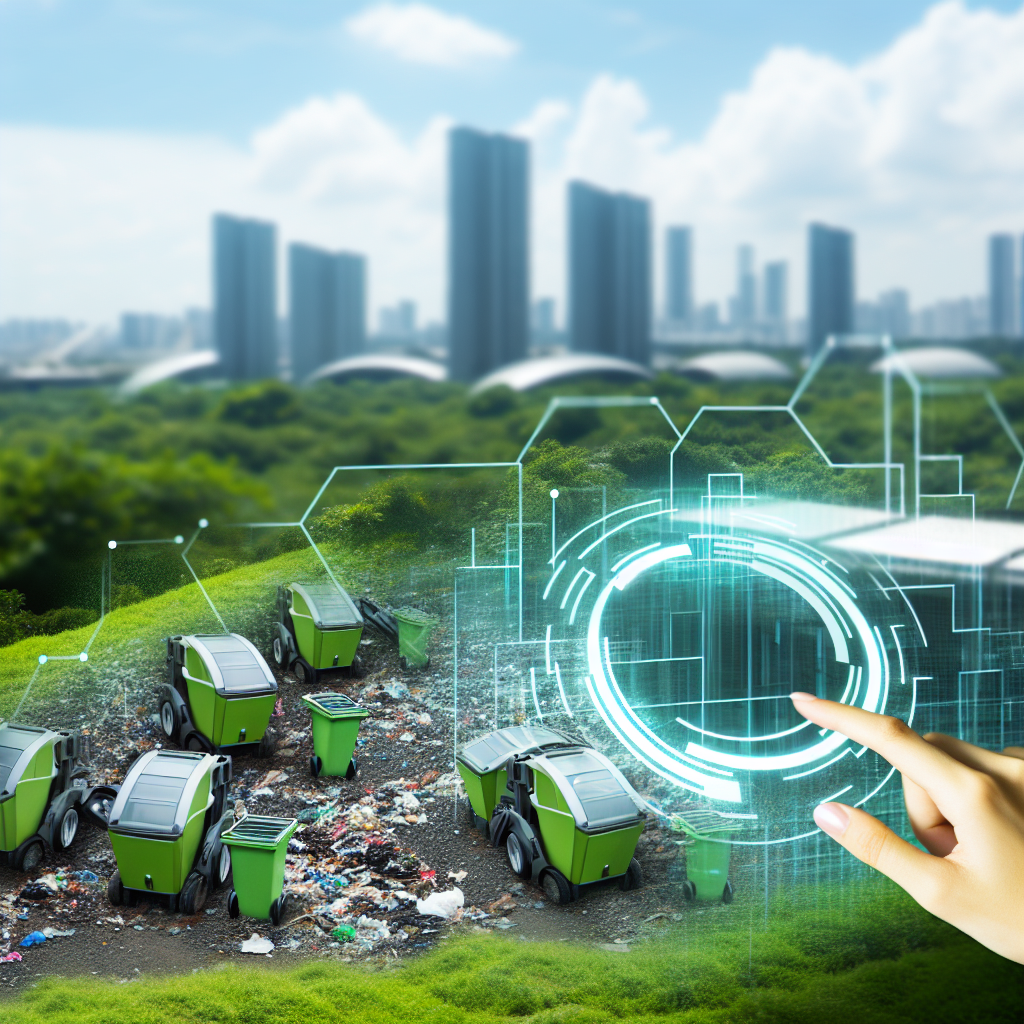Revolutionizing Waste Management: How IoT Waste Solutions Are Transforming Valet Trash Services in 2025
In recent years, the waste management industry has witnessed a significant transformation, driven by the integration of Internet of Things (IoT) technologies. As we look towards 2025, valet trash services are at the forefront of this revolution, leveraging IoT solutions to enhance efficiency, sustainability, and customer satisfaction. The adoption of IoT in waste management is not merely a trend but a strategic evolution that addresses the growing demands for smarter, more sustainable urban living.
At the core of this transformation is the ability of IoT devices to collect and analyze data in real-time. Smart sensors, for instance, are being deployed in waste bins to monitor fill levels, detect odors, and even identify the types of waste being disposed of. This data is then transmitted to a centralized system, allowing valet trash service providers to optimize collection routes and schedules. Consequently, this leads to a reduction in fuel consumption and carbon emissions, aligning with global sustainability goals. Moreover, the real-time data enables service providers to respond promptly to any issues, such as overflowing bins, thereby enhancing the overall customer experience.
Furthermore, the integration of IoT technologies facilitates predictive maintenance of waste collection equipment. By analyzing data patterns, service providers can anticipate equipment failures before they occur, minimizing downtime and ensuring uninterrupted service. This proactive approach not only extends the lifespan of the equipment but also reduces operational costs, which can be passed on as savings to customers. Additionally, the use of IoT in valet trash services supports the implementation of dynamic pricing models. By analyzing data on waste generation patterns, service providers can offer customized pricing plans that reflect the actual usage, providing a fairer and more transparent billing system.
Another significant advantage of IoT waste solutions is their contribution to enhancing recycling efforts. Smart bins equipped with IoT sensors can sort waste at the source, separating recyclables from non-recyclables. This not only increases the efficiency of recycling processes but also reduces contamination rates, which is a major challenge in traditional recycling systems. By improving the quality of recyclable materials, valet trash services can contribute to a more circular economy, where waste is minimized, and resources are reused.
Moreover, the integration of IoT in valet trash services is fostering greater community engagement. Through mobile applications, residents can receive notifications about collection schedules, recycling tips, and even track their waste generation habits. This increased transparency and accessibility empower residents to make more informed decisions about their waste disposal practices, fostering a culture of sustainability within communities.
As we approach 2025, the role of IoT in transforming valet trash services is becoming increasingly evident. The ability to harness real-time data not only enhances operational efficiency but also supports broader environmental and social objectives. However, the successful implementation of these technologies requires collaboration between technology providers, waste management companies, and local governments. By working together, these stakeholders can overcome challenges such as data privacy concerns and infrastructure limitations, ensuring that the benefits of IoT waste solutions are fully realized.
In conclusion, the integration of IoT technologies in valet trash services represents a paradigm shift in waste management. By embracing these innovations, service providers can deliver more efficient, sustainable, and customer-centric solutions, paving the way for smarter cities and a cleaner planet. As we continue to explore the potential of IoT in this sector, it is clear that the future of waste management lies in the seamless fusion of technology and environmental stewardship.
Smart Trash Systems: The Future of Automated Collection in Valet Trash Services
As we look towards 2025, the landscape of valet trash services is poised for a significant transformation, driven by the integration of smart trash systems. These innovations promise to revolutionize the way waste is collected, managed, and processed, offering a more efficient and environmentally friendly approach. At the heart of this transformation is the adoption of automated collection systems, which leverage advanced technologies to streamline operations and enhance service delivery.
One of the key components of smart trash systems is the use of Internet of Things (IoT) technology. IoT-enabled trash bins are equipped with sensors that monitor the fill levels of waste containers in real-time. This data is then transmitted to a centralized system, allowing service providers to optimize collection routes and schedules. By ensuring that trash is collected only when bins are nearing capacity, these systems reduce unnecessary trips, thereby lowering fuel consumption and minimizing the carbon footprint of waste collection operations.
Moreover, the integration of artificial intelligence (AI) into valet trash services is set to further enhance the efficiency of automated collection systems. AI algorithms can analyze data collected from IoT sensors to predict waste generation patterns and adjust collection schedules accordingly. This predictive capability not only improves operational efficiency but also enhances customer satisfaction by ensuring that waste is collected promptly and consistently.
In addition to optimizing collection routes, smart trash systems also offer significant benefits in terms of waste sorting and recycling. Advanced sorting technologies, such as robotic arms and machine learning algorithms, can be employed to automatically separate recyclables from non-recyclables at the point of collection. This not only reduces the burden on recycling facilities but also increases the overall recycling rate, contributing to a more sustainable waste management system.
Furthermore, the implementation of smart trash systems can lead to cost savings for both service providers and customers. By reducing the number of collection trips and optimizing resource allocation, service providers can lower operational costs, which can be passed on to customers in the form of reduced service fees. Additionally, the increased efficiency and accuracy of automated systems can lead to fewer missed collections and service disruptions, further enhancing the value proposition for customers.
As we move towards 2025, it is essential for stakeholders in the valet trash industry to embrace these technological advancements and invest in the development and deployment of smart trash systems. Collaboration between technology providers, waste management companies, and regulatory bodies will be crucial in ensuring the successful implementation of these innovations. By working together, these stakeholders can address potential challenges, such as data privacy concerns and the need for standardized protocols, to create a seamless and efficient waste management ecosystem.
In conclusion, the future of valet trash services lies in the adoption of smart trash systems that leverage IoT, AI, and advanced sorting technologies. These innovations promise to enhance the efficiency, sustainability, and cost-effectiveness of waste collection operations, ultimately benefiting both service providers and customers. As we look towards 2025, it is imperative for the industry to embrace these changes and work collaboratively to realize the full potential of automated collection systems. Through strategic investments and partnerships, the valet trash industry can lead the way in creating a smarter, more sustainable future for waste management.
Innovative Strategies for 2025: Leveraging Modern Waste Solutions in Valet Trash Tech
As we approach 2025, the landscape of valet trash services is poised for a transformative shift, driven by technological advancements and innovative strategies. The integration of modern waste solutions is not only enhancing operational efficiency but also redefining customer experiences. At the forefront of this evolution is the adoption of smart technologies, which are increasingly becoming indispensable in the realm of waste management. These technologies are enabling service providers to streamline operations, reduce costs, and improve sustainability outcomes.
One of the most significant innovations in valet trash services is the implementation of Internet of Things (IoT) devices. These devices are revolutionizing the way waste is collected and managed by providing real-time data on waste levels, collection schedules, and bin usage. By leveraging IoT technology, service providers can optimize collection routes, thereby reducing fuel consumption and minimizing the carbon footprint. This not only contributes to environmental sustainability but also enhances the overall efficiency of the service.
In addition to IoT, artificial intelligence (AI) is playing a crucial role in advancing valet trash services. AI algorithms are being utilized to predict waste generation patterns, allowing for more accurate forecasting and resource allocation. This predictive capability ensures that resources are deployed where they are needed most, reducing waste overflow and improving customer satisfaction. Furthermore, AI-driven analytics provide valuable insights into consumer behavior, enabling service providers to tailor their offerings to meet the evolving needs of their clients.
Another innovative strategy gaining traction is the use of mobile applications to enhance customer engagement and service delivery. These apps offer a convenient platform for residents to schedule pickups, report issues, and receive notifications about service updates. By facilitating seamless communication between service providers and customers, mobile apps are fostering a more responsive and customer-centric approach to valet trash services. Moreover, the integration of digital payment systems within these apps is streamlining transactions, making the process more efficient and user-friendly.
Sustainability is also a key focus area for valet trash services as we move towards 2025. The adoption of eco-friendly practices, such as recycling and composting, is becoming increasingly important. Service providers are exploring innovative ways to incorporate these practices into their operations, thereby reducing the amount of waste sent to landfills. For instance, some companies are partnering with recycling facilities to ensure that recyclable materials are properly sorted and processed. Others are investing in composting initiatives to convert organic waste into valuable resources.
Furthermore, the concept of circular economy is gaining momentum in the valet trash industry. By promoting the reuse and repurposing of materials, service providers are not only reducing waste but also creating new business opportunities. This approach aligns with the growing consumer demand for sustainable and environmentally responsible services.
In conclusion, the future of valet trash services is being shaped by a confluence of technological innovations and sustainable practices. As we look towards 2025, it is clear that the integration of IoT, AI, and mobile technologies will continue to drive efficiency and enhance customer experiences. At the same time, a commitment to sustainability will ensure that these services contribute positively to the environment. By embracing these expert strategies, valet trash service providers are well-positioned to meet the challenges and opportunities of the future, delivering value to both their customers and the planet.
Discover cutting-edge strategies and innovations shaping the future of valet trash services. Stay ahead in 2025 with expert insights. Learn more.



